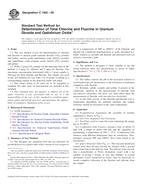Potřebujeme váš souhlas k využití jednotlivých dat, aby se vám mimo jiné mohly ukazovat informace týkající se vašich zájmů. Souhlas udělíte kliknutím na tlačítko „OK“.
ASTM C1474-00(2011)
Standard Test Method for Analysis of Isotopic Composition of Uranium in Nuclear-Grade Fuel Material by Quadrupole Inductively Coupled Plasma-Mass Spectrometry
Automaticky přeložený název:
Standardní zkušební metoda pro analýzu izotopové složení uranu v jaderných naftu materiálu kvadrupól indukčně vázanou plazmou, hmotnostní spektrometrie
NORMA vydána dne 1.6.2011
Informace o normě:
Označení normy: ASTM C1474-00(2011)
Poznámka: NEPLATNÁ
Datum vydání normy: 1.6.2011
Kód zboží: NS-11431
Počet stran: 9
Přibližná hmotnost: 27 g (0.06 liber)
Země: Americká technická norma
Kategorie: Technické normy ASTM
Kategorie - podobné normy:
Anotace textu normy ASTM C1474-00(2011) :
Keywords:
inductively coupled plasma-mass spectrometry (ICP-MS), isotopic ratio, uranium, ICS Number Code 27.120.30 (Fissile materials and nuclear fuel technology)
Doplňující informace
| Significance and Use | ||||||||||||||||||||
|
Nuclear-grade reactor fuel material must meet certain criteria, such as those described in Specifications C 753, C 776, C 778, and C 833. Included in these criteria is the uranium isotopic composition. This test method is designed to demonstrate whether or not a given material meets an isotopic requirement and whether the effective fissile content is in compliance with the purchaser’specifications. |
||||||||||||||||||||
| 1. Scope | ||||||||||||||||||||
|
1.1 This test method is applicable to the determination of the isotopic composition of uranium (U) in nuclear-grade fuel material. The following isotopic weight percentages are determined using a quadrupole inductively coupled plasma-mass spectrometer (Q-ICP-MS): 233U, 234U, 235U, 236U, and 238U. The analysis can be performed on various material matrices after acid dissolution and sample dilution into water or dilute nitric (HNO3) acid. These materials include: fuel product, uranium oxide, uranium oxide alloys, uranyl nitrate (UNH) crystals, and solutions. The sample preparation discussed in this test method focuses on fuel product material but may be used for uranium oxide or a uranium oxide alloy. Other preparation techniques may be used and some references are given. Purification of the uranium by anion-exchange extraction is not required for this test method, as it is required by other test methods such as radiochemistry and thermal ionization mass spectroscopy (TIMS). This test method is also described in ASTM STP 1344 . 1.2 The 233U isotope is primarily measured as a qualitative measure of its presence by comparing the 233U peak intensity to a background point since it is not normally found present in materials. The example data presented in this test method do not contain any 233U data. A 233U enriched standard is given in Section 8, and it may be used as a quantitative spike addition to the other standard materials listed. 1.3 A single standard calibration technique is used. Optimal accuracy (or a low bias) is achieved through the use of a single standard that is closely matched to the enrichment of the samples. The intensity or concentration is also adjusted to within a certain tolerance range to provide good statistical counting precision for the low-abundance isotopes while maintaining a low bias for the high-abundance isotopes, resulting from high-intensity dead time effects. No blank subtraction or background correction is utilized. Depending upon the standards chosen, enrichments between depleted and 97 % can be quantified. The calibration and measurements are made by measuring the intensity ratios of each low-abundance isotope to the intensity sum of 233U, 234U, 235U, 236U, and 238U. The high-abundance isotope is obtained by difference. 1.4 The values stated in SI units are to be regarded as the standard. The values given in parentheses are for information only. The instrument is calibrated and the samples measured in units of isotopic weight percent (Wt %). For example, the 235U enrichment may be stated as Wt % 235U or as g 235U/100 g of U. Statements regarding dilutions, particularly for ug/g concentrations or lower, are given assuming a solution density of 1.0 since the uranium concentration of a solution is not important when making isotopic ratio measurements other than to maintain a reasonably consistent intensity within a tolerance range. 1.5 This standard does not purport to address all of the safety concerns, if any, associated with its use. It is the responsibility of the user of this standard to establish appropriate safety and health practices and determine the applicability of regulatory limitations prior to use. Specific precautionary statements are given in Section 9. |
||||||||||||||||||||
| 2. Referenced Documents | ||||||||||||||||||||
|
Podobné normy:
Historická
1.1.2013
Historická
1.1.2014
Historická
1.1.2014
Historická
1.2.2009
Historická
1.6.2009
Historická
1.6.2009
Odebírejte informace o nově vydaných normách ZDARMA:
Chcete pravidelně odebírat informace o nově vycházejících normách z celého světa a to zcela zdarma?
Přihlašte se k odběru. Vše je velice jednoduché a absolutně ZDARMA.
Na výběr máte vydavatele z celého světa.



 ASTM C1462-00(2013)..
ASTM C1462-00(2013).. ASTM C1477-08(2014)..
ASTM C1477-08(2014).. ASTM C1490-14
ASTM C1490-14 ASTM C1493-09
ASTM C1493-09 ASTM C1502-09
ASTM C1502-09 ASTM C1517-09
ASTM C1517-09
 Cookies
Cookies
